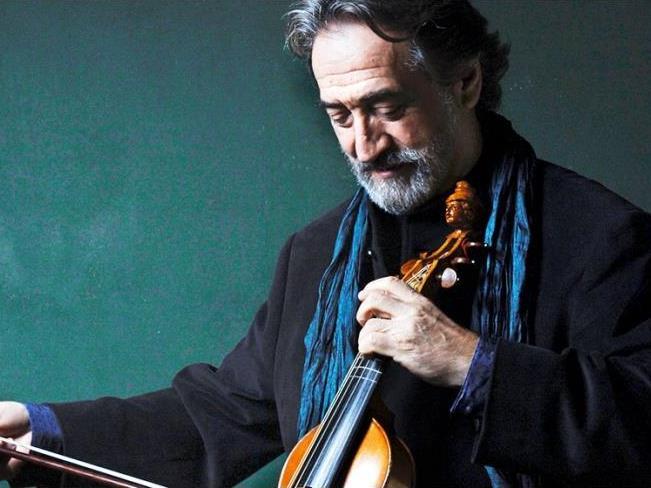Image: Jordi Savall via MRC.
Since first touring Australia in 1996, Catalan gambist Jordi Savall and his ensemble Hespèrion XX (now Hespèrion XXI) have mesmerised our audiences for their innovative programming and profoundly moving performances. Given the ensemble’s extensive discography Savall’s performing agenda is now fuller than ever before. On Wednesday and Thursday nights the group returned to play to sold-out performances in the refined, wood-lined acoustic of Elisabeth Murdoch Hall within the Melbourne Recital Centre en route the Festival of Perth, the New Zealand Festival in Wellington, the Sydney Opera House Concert Hall and finally a performance in Brisbane at the Queensland Performing Arts Centre tonight. On Friday this week a new tour and program commences in Oslo, Norway. On this occasion the ensemble was accompanied by the Mexican Tembembe Ensamble Continuo in the first of two programs: Folías Antiguas y Criollas: From the Ancient World to the New World and Folías y Romanescas: The Golden Age of the Viol.
For decades Savall’s artistic focus has explored European music from the Middle Ages to the Baroque, cultures that were never stagnant as history may sometimes encourage us to believe but always open to the cultural influences of trade, political upheaval and religious conflict. More recently he has convincingly demonstrated that cities such as Jerusalem and Istanbul were cultural melting pots, and that Western music exerted a powerful influence in the New World. In these unique programs Savall collaborates with expert musicians from each culture to encourage the view that music provides the opportunity to transcend barriers and appease past and present struggles.
Tembembe Ensamble Continuo comprises all manner of accompanying strings strummed, plucked and bowed, a fascinating array of percussion instruments – including the Quijada de caballo made from the lower jawbone of a horse that is struck causing the teeth to rattle, the Marimbol a giant version of the African thumb piano presumably originally imported via the slave trade – and on this occasion a fandango dancer and two singers. The program aimed to restore the musical connections between Hispanic Baroque music and traditional music, particularly through dance and song, from Mexico and Latin America.
Folías in Portuguese means both ‘wild amusement’ and ‘insanity’. Like the 12-bar blues it contains a repeated harmonic pattern over which musicians extemporised, often building in texture, virtuosity and fervour. The entire first program Folías Antiguas y Criollas: From the Ancient World to the New World involved an improvisatory element. Much of the music, being on the lighter side, was attractively enjoyable though it sometimes verged towards being inconsequential. Although the fandango dancing was somewhat underwhelming, the declamatory singing was both rustic and true. There were some Hespèrion XXI standards that enchanted, particularly the searing melodic beauty of Glosas sobre Todo el mundo en general by Francesco Correa de Arrauxo played by Savall on treble viol and the exquisitely delicate Canarios improvisations (anon).
The second program Folías y Romanescas: The Golden Age of the Viol exploring music from England to Peru provided more serious fare and contained several exquisite instrumental solos: notably harpist Andrew Lawrence-King’s heart-wrenching performance of Dowland’s Lachrimae Pavane ‘Flow my teares’, Jordi Savall’s elegant Marin Marais Suite and lutenist Xavier Días-Latorre’s soothing Pasacaille by Robert de Visée, the latter a composer and guitarist in the employ of the court of Louis XIV. It was particularly these tantalizing solo works, sounding splendid in the Elisabeth Murdoch Hall, that illuminated.
Jordi Savall’s viol playing is incomparable. Always stemming from an initial position of silence, there follows a rich envelope of sound that once again disappears into silence. The entire ensemble seemed to emulate his performance style. Nothing is ever forced or loud. The ensemble music delighted for its subtlety, complexity and the balanced refinement of each work’s arrangement. As a result I’ve never witnessed such numbers listening so intently. Even the performers’ stage presence is careful and solemn, including respectful and dignified slow bows. The entire effect is life-affirming, civilising and profoundly reassuring that perhaps the world is not after all destined for annihilation.
Both performances received standing ovations with the audience demanding more. May Savall’s next visit be not too far away.
Rating: 4 ½ stars out of 5
Jordi Savall, Hespèrion XXI & Tembembe Ensamble Continuo
Jordi Savall, treble and bass viol/director
Hespèrion XXI
Xavier Díaz-Latorre, guitar and theorbo
Andrew Lawrence-King, Spanish Baroque harp and Italian Baroque triple harp (arpa doppia)
Xavier Puertas, violone
David Mayoral, percussion
Tembembe Ensamble Continuo
Donají Esparza, dance, zapateado
Ada Coronal, vihuela, voice
Zenen Zeferino, jarana jarocha 3a, voice
Leopoldo Novoa, matimbol, guitarra de son 3a, jarana huasteca, quijada de caballo, arpa llanera
Enrique Barona, huapanguera, leona, jarana jorocha 3a, mosquito, maracas, pander, dance, voice
Ulises Martínez, violin, voice
Elisabeth Murdoch Hall, Melbourne Recital Centre
Wednesday, 21 February, 2018
Thursday, 22 February, 2018
7.30pm
Presented by Melbourne Recital Centre





